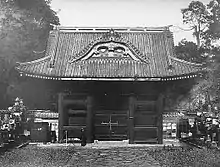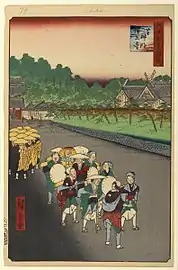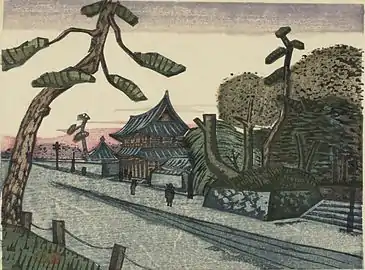Zōjō-ji
Zōjō-ji (増上寺) is a Jōdo-shū Buddhist temple in Tokyo, Japan. It is the main temple of the Jōdo-shū ("Pure Land") Chinzei sect of Buddhism in the Kantō region,.[1][2] Its mountain name is San'en-zan (三縁山).
| Zōjō-ji | |
|---|---|
三縁山増上寺 | |
 Hondo (main hall) and the Tokyo Tower | |
| Religion | |
| Affiliation | Jōdo-shū |
| Deity | Buddha |
| Location | |
| Location | 4 Chome-7-35 Shibakoen, Minato, Tokyo 105-0011 |
| Country | Japan |
| Architecture | |
| Founder | Yūyo Shōsō |
| Completed | 1393 |
| Website | |
| zojoji.or | |

Zōjō-ji is notable for its relationship with the Tokugawa clan, the rulers of Japan during the Edo period, with six of the Tokugawa shōguns being buried in the Taitoku-in Mausoleum in the temple grounds. Also, the temple's Sangedatsumon (main gate) is the oldest wooden building in Tokyo, dating from 1622. The original buildings, temples, mausoleums and the cathedral were destroyed by fire, natural disasters or air raids during World War II.[3]
It is located in the Shiba neighborhood of Minato. The Shiba Park is built around the temple, with the Tokyo Tower standing beside it. In 2015 a Treasure Gallery was opened on the underground level of the Daiden (great hall), and it currently houses paintings of Kanō Kazunobu and a model of the Taitoku-in Mausoleum.
The temple remains active "as the main temple of Jodo shu and the central nembutsu seminary for priests and novices."[4]
History
Shūei (宗叡, 809-884), a disciple of Kūkai, founded a temple named Kōmyō-ji (光明寺) at Kaizuka (貝塚, present-day Kōjimachi in Chiyoda, Tokyo);[5] it is said to have been the forerunner of Zōjō-ji. In 1393, during the Muromachi period, the temple, under its abbot Yūyo Shōsō, converted from Shingon to the Jōdo school. Shōsō is thus regarded as the founder of Zōjō-ji.[6]
Together with Kan'ei-ji, during the Edo period Zōjō-ji was the Tokugawa's family temple.[7] Tokugawa Ieyasu had the temple moved, first to Hibiya, then in 1590, at the time of expansion of Edo Castle, to its present location.[8]
With the fall of the Tokugawa shogunate, the grounds took on the character of a public park. The temple was badly damaged in World War II, but still retains the air of a major temple.[9]
Architecture
At its peak the temple grounds had more than 120 buildings, but following the decline of Buddhism during the Meiji period (1868-1912), most of them burned during the Bombing of Tokyo in World War II. Reconstruction began after the war, with the Daiden (great hall) being rebuilt in 1974.[9]







Sangedatsumon
The 21 meter (69 foot) two-storied main gate, Sangedatsumon (三解脱門) was constructed in 1622,[9] and it is therefore the oldest wooden building in Tokyo.[10] The temple's only original structure to survive the Second World War,[11] it has been designated an Important Cultural Property.
"San" (三) means "three", and "Gedatsu" (解脱) means "Moksha". If someone passes through the gate, he can free himself from three passions (貪 Ton; "greed", 瞋 Shin; "hatred", 癡 Chi; "foolishness").[9]
On the upper floor are enshrined an image of Gautama Buddha flanked by two attendants, and statues of the Sixteen Arhats.[9]
Mausoleum of Tokugawa Shōguns
Six of the 15 Tokugawa shōguns are buried at Zōjō-ji.[12] The Taitoku-in Mausoleum of Hidetada (and the monument to his wife Sūgen'in), Ienobu, and Ietsugu had been designated National Treasures of Japan, but were burned in World War II. At present, parts of two of their graves have the distinction of being Important Cultural Properties of Japan. Additional graves are located in the cemetery behind the Great Hall. Parts of the former grounds of the temple are now occupied by a park and two hotels. Tokugawa Iemochi also Iemochi's wife, Kazu-no-Miya Chikako also buried in Zozo-ji.
Sentai Kosodate Jizō (Unborn Children Garden)
In one particular garden at the cemetery, rows of stone statues of children represent unborn children, including miscarried, aborted, and stillborn children. Parents can choose a statue in the garden and decorate it with small clothing and toys. Usually the statues are accompanied by a small gift for Jizō, the guardian of unborn children, to ensure that they are brought to the afterlife. Occasionally stones are piled by the statue; this is meant to ease the journey to the afterlife.
Other structures
- Daiden (Great Hall) 1974
- Ankokuden
- Sutra Repository
- Treasures Gallery
- Bell tower
- Enko Daishi Hall
- Koshoden
Access
There is no admission fee for visitors to enter the temple complex.[13] For the Treasure Gallery museum the access fee is (as of 2017, 700 yen).[14]
The entrance is at a 10-minute walk from Hamamatsucho Station on the JR Yamanote and Keihin-Tōhoku Lines, a 6-minute walk from Daimon Station on the Toei Asakusa and Toei Oedo Lines, a 3-minute walk from Onarimon and Shibakoen Stations on the Toei Mita Line, and about 500 meters from the Shibakoen exit of the Shuto Expressway.[9]
While not immediately obvious, the temple grounds are somewhat wheelchair-accessible if entering from the side street instead of the main gate.[15]
Annual events
- Hatsumōde (New Year's visit) January
- Kurohonzon Prayer Ceremony, 15 January
- Setsubun Tsuina-shiki / Nehan Ceremony (Nirvana Day) February
- Spring Higan Ceremony, March
- Gyoki Ceremony / Buddha's Birthday (Flower Festival) April
- Kurohonzon Prayer Ceremony, 15 May
- O-bon / Kaisan-ki / Bon Odori, July
- Peace Prayer Ceremony, August
- Autumn Higan Ceremony / Takigi Noh, September
- Kurohonzon Prayer Ceremony, 15 September
- Juya Hoyo (Ten Nights of Prayer) November
- Jodo Ceremony (Bodhi Day) / Butsumyo Ceremony / Joya no Kane (New Year's Eve Bell Ringing) December[9]
Monthly events[9]
- Sutra copying, 14th (except July and August)
- Betsuji Nembutsu, 24th
Popular culture
Zōjō-ji was depicted multiple times in the art work of the Shin hanga artist Kawase Hasui during the 1920s and 30s. It was also shown in several ukiyo-e prints by Hiroshige, in particular twice in his famous One Hundred Famous Views of Edo series from 1856–1858.
- Zōjō-ji in ukiyo-e
 Zojoji Pagoda and Akabane (1857) by Hiroshige
Zojoji Pagoda and Akabane (1857) by Hiroshige Shiba Shinmei Shrine and Zojoji Temple (1857) by Hiroshige
Shiba Shinmei Shrine and Zojoji Temple (1857) by Hiroshige-IMG_9360.JPG.webp) Snow over Zojoji Temple (1921) by Hasui Kawase
Snow over Zojoji Temple (1921) by Hasui Kawase Snow at Zōjō Temple (1922) by Hasui Kawase
Snow at Zōjō Temple (1922) by Hasui Kawase Zōjō-ji in Shiba (1925) by Hasui Kawase
Zōjō-ji in Shiba (1925) by Hasui Kawase Zôjô-ji (1929) by Fukazawa Sakuichi
Zôjô-ji (1929) by Fukazawa Sakuichi
See also
- Kenchū-ji in Nagoya
- Glossary of Japanese Buddhism
References
- "Zojoji Temple". Japan Guide. Retrieved 2017-12-07.
- "Zōjō-ji: History". Zōjō-ji. Retrieved 2017-12-07.
- Joy, Alicia (21 September 2016). "A Brief History of Zojoji".
- Official website
- "Zojo-ji Temple". Japan National Tourism Organization. Retrieved 2017-12-07.
- "Zōjō-ji: History". Zōjō-ji. Retrieved 2017-12-07.
- "Zojoji Temple 三縁山増上寺". Japan Visitor. Retrieved 2017-12-07.
- "Zōjō-ji: History". Zōjō-ji. Retrieved 2017-12-07.
- English pamphlet from Zōjō-ji
- "Zojoji Temple 三縁山増上寺". Japan Visitor. Retrieved 2017-12-07.
- "Zojoji Temple 三縁山増上寺". Japan Visitor. Retrieved 2017-12-07.
- "Zojo-ji Temple". Japan National Tourism Organization. Retrieved 2017-12-07.
- "Zojo-ji Temple". Japan National Tourism Organization. Retrieved 2017-12-07.
- "Zojoji - Treasure Gallery". 19 February 2016. Retrieved 2017-12-07.
- "Zojoji Temple - Accessible Japan | アクセシブルジャパン". Accessible Japan | アクセシブルジャパン. Retrieved 2018-03-19.
.jpg.webp)
